Homoplantaginin (Synonyms: Hispidulin-7-O-D-glucoside) |
| Catalog No.GC31692 |
A flavonoid glycoside with antioxidant and anti-inflammatory activities
Products are for research use only. Not for human use. We do not sell to patients.

Cas No.: 17680-84-1
Sample solution is provided at 25 µL, 10mM.
Homoplantaginin is a flavonoid from a traditional Chinese medicine Salvia plebeia with antiinflammatory and antioxidant properties. Homoplantaginin could inhibit TNF-α and IL-6 mRNA expression, IKKβ and NF-κB phosphorylation.
Homoplantaginin shows IC50 of reduction level of DPPH radical at 0.35 μg/mL. In human hepatocyte HL-7702 cells exposed to H2O2, the addition of 0.1-100μg/mL of homoplantaginin significantly reduces lactate dehydrogenase leakage, and increases glutathione, glutathione peroxidase and superoxide dismutase in supernatant[1]. Homoplantaginin (0.1, 1, 10 μM) dose-dependently reduces expression of toll-like receptor-4 evoked by palmitic acid (100 μM). Homoplantaginin tightly controlls palmitic acid-induced reactive oxygen species to prevent nucleotide-binding domain-like receptor 3 (NLRP3) inflammasome activation by suppressing reactive oxygen species-sensitive thioredoxin-interacting protein, NLRP3, and caspase-1[2]. Pre-treatment of homoplantaginin on human umbilical vein endothelial cells significantly inhibits palmitic acid induced TNF-α and IL-6 mRNA expression, and IKKβ and NF-κB p65 phosphorylation. Homoplantaginin significantly modulates the Ser/Thr phosphorylation of IRS-1, improves phosphorylation of Akt and endothelial nitric oxide synthase, and increases NO production in the presence of insulin[3].
Homoplantaginin(25-100mg/kg) significantly reducesthe increase in serum alanine aminotranseferase and aspartate aminotransferase, decreases the levels of TNF-α and IL-1. The same treatment also reduces the content of thiobarbituric acid-reactive substances, elevates the levels of GSH, GSH-Px and SOD in hepatic homogenate[1]. Homoplantaginin is rapidly absorbed (Tmax=16.00±8.94min), reaching a mean Cmax between 0.77 and 1.27nmol/mL. The absolute oral bioavailability is calculated to be only 0.75%.
[1]. Qu XJ, et al. Protective effects of Salvia plebeia compound homoplantaginin on hepatocyte injury. Food Chem Toxicol. 2009 Jul;47(7):1710-5. [2]. He B, et al. Homoplantaginin Inhibits Palmitic Acid-induced Endothelial Cells Inflammation by Suppressing TLR4 and NLRP3 Inflammasome. J Cardiovasc Pharmacol. 2016 Jan;67(1):93-101. [3]. Wu F, et al. Homoplantaginin modulates insulin sensitivity in endothelial cells by inhibiting inflammation. Biol Pharm Bull. 2012;35(7):1171-7. [4]. Cong Y, et al. Pharmacokinetics of homoplantaginin in rats following intravenous, peritoneal injection and oral administration. J Pharm Biomed Anal. 2016 Sep 10;129:405-9.
Average Rating: 5 (Based on Reviews and 8 reference(s) in Google Scholar.)
GLPBIO products are for RESEARCH USE ONLY. Please make sure your review or question is research based.
Required fields are marked with *




















